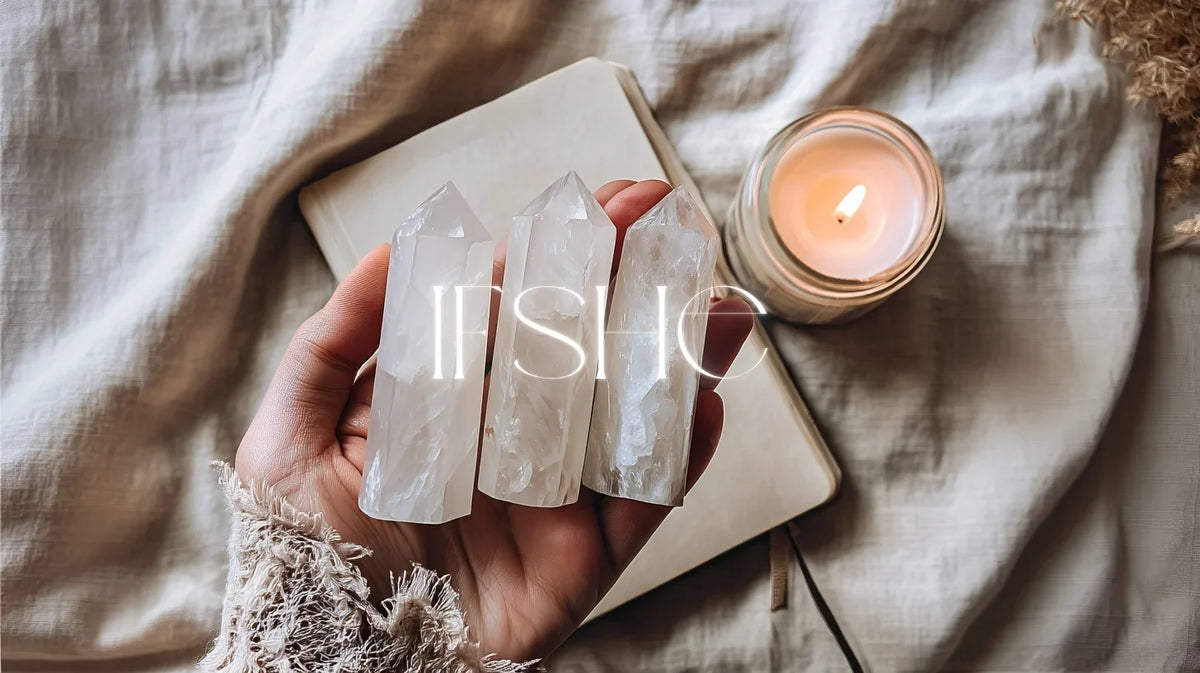
What Are Healing Crystals? Beginner’s Guide
|
Time to read 7 min
|
Time to read 7 min
IN THIS ARTICLE
| Crystal | Color | Traditional Keyword | Everyday Example Scenario |
|---|---|---|---|
| Amethyst (Quartz) | Purple | Calm & clarity | Keep a palm-stone on your desk to curb doom-scrolling during work breaks. |
| Rose Quartz | Soft pink | Self-love & compassion | Slip a tumbled piece into your bath ritual as a gentle “me-time” reminder. |
| Citrine (Heat-treated Amethyst or Natural Quartz) | Golden yellow | Abundance & motivation | Display a citrine point near your budgeting journal to channel prosperity vibes. |
| Black Tourmaline | Inky black | Grounding & protection | Tape a thin slice to the back of your Wi-Fi router if electromagnetic smog worries you. |
| Clear Quartz | Transparent | Amplification | Pair with other stones in a grid to super-charge intentions—like adding garlic to pasta sauce. |
| Green Aventurine | Mossy green | Opportunity & luck | Carry during job interviews as a tactile confidence booster. |
| Selenite (Gypsum) | Milky white, satiny | Energetic cleansing | Use a wand to “comb” around your aura after tense meetings (it won’t judge your presentation skills). |
| Lapis Lazuli | Deep blue with pyrite flecks | Truth & insight | Rest on your third eye point during meditation to spark dream recall. |
| Carnelian | Fiery orange | Creativity & vitality | Pop a small cabochon on your guitar amp while composing that hit song. |
| Hematite | Metallic gray | Focus & blood flow | Place beneath your chair during study marathons—think of it as a magnetic anchor. |
Pro-tip: Not every attribute is rooted in ancient scripture; many emerged from 20th-century metaphysical literature. Feel free to explore what personally resonates instead of memorizing a universal cheat sheet.
Let’s address the sparkling elephant in the room: double-blind studies have yet to prove crystals heal disease. But dismissing them outright misses intriguing nuances.
Placebo Power. In a 2001 experiment, participants who meditated with either genuine or fake quartz reported similar sensations (Wiseman et al., 2001). The takeaway: expectation can be medicinal.
Mindfulness Overlap. A 2019 functional-MRI study found that simply holding an object while focusing on breath increased activity in brain regions tied to interoception and calm regulation (2019 MRI study). The object—whether a crystal or stress ball—acted as an anchor.
Material Science Crossovers. Universities researching piezo-electric implants for bone healing indirectly support the idea that mineral lattices interact with biology, albeit at different scales.
So, while your rose-hued friend won’t replace antibiotics, it may amplify intentional practices that are evidence-based: mindfulness, gratitude journaling, and stress reduction.
Meditation Partners
Hold a stone in your non-dominant hand to receive energy.
Match crystal color to chakra point (e.g., blue sodalite on throat).
Wearable Reminders
Necklaces keep stones close to the heart and throat centers.
Bracelets turn each glance at your wrist into a micro-check-in with intentions.
Crystal Grids
Arrange stones in geometric patterns (flower of life, spiral).
Center stone = focus, surrounding stones = support team.
Charge with a verbal affirmation; leave intact for lunar cycle.
Elixirs & Essences
Indirect method only for toxic minerals (e.g., malachite contains copper). Place stone in a sealed glass, then submerge that glass in water overnight.
Label bottle with preparation date; refrigerate and use within 24 hours.
Home & Office Feng Shui
Amethyst cluster near electronics softens aesthetics and (some say) EMF load.
Citrine in the wealth corner (far left from your front door) feels like a piggy bank upgrade.
Sleep Support
A moonstone palm stone under your pillow can serve as a tactile cue to practice pre-bed gratitude lists instead of scrolling nocturnal newsfeeds.
Safety Note: Always research mineral composition before water or skin contact; a quick Google of “is (stone) safe for water?” saves headaches—and possibly heavy-metal exposure.
Authenticity Checks
Uniformly bright “aura quartz” likely equals heat-treated titanium coating. That’s fine if you love it—but pay a coating price, not natural rarity price.
Ethical Mining
Look for sellers who provide country-of-origin data and fair-trade certifications. Malagasy quartz mined by co-ops supports local wages; unregulated mines may fund unsafe labor.
Eco-Packaging
Request recycled or minimal packaging. Glassine bags beat plastic foam peanuts on landfill points.
Local Alternatives
Rock-hounding clubs offer field trips where you dig your own agates—zero cargo-ship footprint and a built-in adventure story.
Running Water Rinse (1 minute): Great for hard stones like quartz; avoid soft selenite—it dissolves faster than sugar in tea.
Smoke Smudge : Pass stone through sage, palo santo, or incense. Intended to reset energy without harsh chemistry.
Moon-Bath : Place crystals on a windowsill during full moonlight. Think of it as solar panels but gentler (and goth-approved).
Sound Bath : A tuning fork or singing bowl vibration shakes off stagnant vibes—no drying rack required.
Frequency & Rationale
New stone? Cleanse immediately.
Heavy emotional use (breakup crying into rose quartz)? Cleanse weekly.
Display pieces that rarely move? Monthly maintenance suffices.
| Myth | Reality Check |
|---|---|
| “Crystals cure diseases outright.” | No peer-reviewed study proves they replace medical treatment. Use them as complementary, not primary, care. |
| “Bigger equals stronger.” | Frequency stability remains regardless of size; a thumbnail sliver can be as effective as a showcase geode. |
| “You must be ‘gifted’ your first crystal.” | Nice sentiment, but self-purchase is perfectly valid—and way faster. |
| “All stones love sunlight.” | Amethyst and rose quartz fade with UV exposure; check durability charts before sun-bathing your gems. |
| “Once cleansed, a crystal stays pure forever.” | Like a reusable coffee mug, it picks up new residues with use—regular maintenance recommended. |